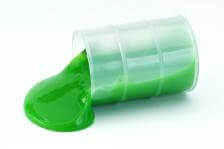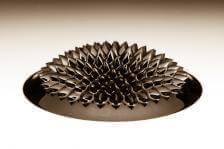Science Experiments at Home: Liquids
Can a liquid ever be a solid? How dense is the densest liquid? Are liquids ever magnetic? Let’s have a look at a few experiments—and the science behind them—that you can do at home to explore the wild and wacky properties of liquids.
Sabrina Stierwalt, PhD
Listen
Science Experiments at Home: Liquids
So, the kids are out from school for the summer, and they are already bored. Or maybe you haven’t been a kid in a while, but you’re missing the experiments you used to do in science class. Here are a few experiments that you can do, with items you most likely already have lying around the house, to explore the fluidity, magnetism, and density of different liquids.
Make Your Own Non-Newtonian Fluid: Oobleck!
Usually, telling the difference between a liquid and a solid is easy. Matter in a liquid state can flow freely and change shape but is not easily compressed and instead maintains a relatively constant volume. Solids are more rigid. They maintain a fixed volume and shape and are thus also not easily compressible.
But can a liquid ever be a solid? Well, not exactly, but some liquids blur the lines normally drawn by these definitions.
Most liquids are what we call Newtonian fluids, a characterization that describes, among other things, their viscosity. Viscosity is a measure of how resistant a substance is to change when different stresses are applied. More viscous liquids, like honey, don’t flow as easily and are considered thicker than less viscous liquids like water. For Newtonian fluids, however, viscosity depends on temperature—if you heat that honey up, it will start to flow more easily.

Start with a wide bowl for mixing. If you’re doing this experiment with kids, pick a space where you can make a mess and put some newspaper down. Put about ½ cup of cornstarch in the bowl and add in ½ cup of water but only 2 Tablespoons or so at a time. Use gentle, slow movements to stir the two ingredients as you mix them together, until all of the cornstarch is wet.
What you’ve made is unofficially referred to as oobleck, after the Dr Seuss book, Bartholomew and the Oobleck. In the story, magicians make oobleck fall from the sky to serve a king who wants something different from the usual rain. (Reading the book is also a great related activity for small children.) In reality, what you’ve made is a non-Newtonian fluid.
Experiment with how your oobleck reacts to different types of motion, like a quick sharp tap with a spoon versus a slow and gentle poke from your finger. When you tap the oobleck, it shouldn’t splash like a “normal” liquid because the force you’ve applied has increased the viscosity and made the oobleck more solid-like. (If your oobleck flows too easily, try adding a bit more cornstarch.)
Next, gather some of your oobleck into a ball in your hand. If you continue to pack it down and apply pressure, the goo will maintain it’s solid-like structure. Once you stop, however, it will start to ooze more like a liquid.
Adding a few drops of food coloring to your oobleck can make the experiment a bit more fun. To take your experiment to the next level, you can make your oobleck dance with the help of sound vibrations by spreading it out over a tray on top of a subwoofer or other powerful speaker. When you’re done, be sure to dilute your oobleck with lots of water before pouring it down the drain. Don’t eat it!
Create and Play With Liquid Magnets!
Are liquids ever magnetic? Yes! But don’t take my word for it—you can make a magnetic liquid, called a ferromagnetic fluid, on your own. This experiment is a messy one, so make sure you’ve got lots of tarps, table cloths, and gloves ready.
Ferromagnetic fluids, or ferrofluids for short, are composed of magnetic, often iron-based nanoparticles, suspended in some kind of carrier fluid, along with a surfactant to prevent clumping. When the ferrofluid comes into contact with a magnet, it will become magnetized. If the magnet is strong enough, the liquid will form dozens of small cones or peaks that are aligned along the magnetic field lines.
In 1963, NASA was looking for a way to pull rocket fuel through an engine that doesn’t require gravity. So, NASA scientist Steve Papell invented ferrofluid as a type of liquid rocket fuel that could be moved using magnetic fields even in a weightless environment.

You can mix your own ferrofluid at home by combining vegetable oil with—and here’s where things get messy—laser jet toner (called MICR), like the stuff you put in your printer. Start with a clear glass jar—one with a narrower neck will be easier to maneuver—and add 3 Tablespoons of toner. Next add 2-3 Tablespoons of vegetable oil and stir.
To best highlight the power of your ferrofluid you’ll need a really strong magnet, like the rare-earth magnets you can find in hardware stores. Move the magnet along the outside of your glass jar and see how the liquid reacts. You should see spikes form pointing in all directions away from the magnet and along the magnetic field lines.
You can also try pouring your ferrofluid onto a plate and running the magnet along underneath. Does the liquid follow? Try tapping the surface of the blob of fluid to see how quickly it reacts.
If this sounds too messy, instead fill a mason jar with water and add your ferrofluid to the jar. You should see the oily substance bead up initially, but then what happens when you run the magnet around the outside of the jar? What if you drop the magnet inside?
Of course, as with our oobleck, ferrofluids are NOT safe for consumption.
Capture Rainbows in a Jar
As discussed in a previous episode, density describes the mass of an object within a certain volume. Given two objects of the same size, the one that is denser (i.e., has more mass packed into that same size or volume) will feel heavier.
In order for something to float in water, it has to be less dense, but not necessarily lighter, than water. This works for liquids floating in water as well. If liquids of different densities are mixed together, they will eventually separate themselves as the denser molecules fall to the bottom and the less dense molecules rise to the top.
At room temperature, mercury is the densest liquid, coming in at more than 13 times as dense as water. Denser liquids can be made from solids if they are melted and thus heated.
We can test the densities of different liquids by mixing several together in a large glass jar like a mason jar. Adding some food coloring to our different liquids will give the effect of having captured a rainbow.
Gather about ¼ to ½ cup (depending on the size of your jar) each of water, dishwashing liquid, olive oil, rubbing alcohol, and corn syrup. Then mix the corn syrup with red and blue food coloring until it’s the right shade of purple and add it to the jar. Next add blue food coloring to the detergent (if it isn’t already blue), and add it to the jar. Then add green food coloring to your water before putting it in the jar. Next, you can mix some red and yellow food coloring to the olive oil to give it a more orange hue or just leave it as is before adding it to the jar. Finally, for the top of your rainbow, add a few drops of red food coloring to the rubbing alcohol and add it.
If you are careful not to bump the jar, since we added the liquids in order from most to least dense, you should see a gorgeous rainbow! The less dense liquids float on top of the denser ones. Now try stirring up your liquids. Will it return to rainbow form? What happens if you repeat the experiment, but add the liquids in the reverse order, starting with the least dense? Try using different colors as well. And, of course, don’t drink it!
Until next time, this is Sabrina Stierwalt with Ask Science’s Quick and Dirty Tips for helping you make sense of science. If you have examples of your own liquid experiments, please share them below in the comments! You can become a fan of Ask Science on Facebook or follow me on Twitter, where I’m @QDTeinstein. If you have a question that you’d like to see on a future episode, send me an email at everydayeinstein@quickanddirtytips.com.

